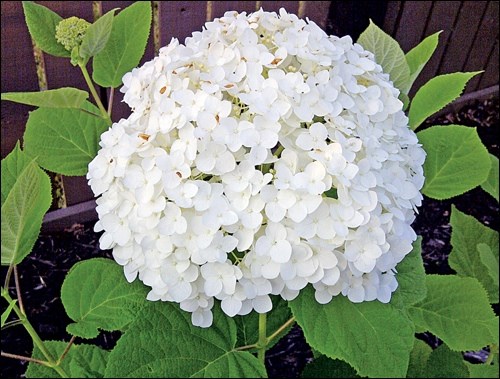Growing up on the West Coast in Victoria, large pink and blue hydrangea shrubs were a common sight. It was one of the things I missed when I moved to Saskatoon nearly 25 years ago. At the time, the only hardy hydrangeas available to Prairie gardeners were Annabelle and PeeGee, the former with large creamy white globes for blooms (6 - 8 inches diameter) and the latter with long poker- or cone-shaped white blooms (6 - 8 inches long). Because they die down to the ground every year like a herbaceous perennial from our cold, cold winters, they rarely reach taller than three feet.
But that was then. Now, if you have a protected yard, there are several new cultivars and species with an expanded colour range including pink, blue and coral. Most are sold as some variation on a 'gardener's challenge' but worth a try anyways.
Three summers ago, I planted several Incrediball hydrangeas in my garden, with the thought that they could form an informal hedge at the back of the border. The promise was that this was an improved Annabelle with larger flowers and sturdier stems. Last year I had no flowers. Disappointed, I intended to replace them all this year. Reading my mind, flower buds formed and dozens of pure white large globes are just beginning to form. None of them have reached the reported 12 inches in diameter yet, but I'm hopeful.
An acreage dwelling friend has tried a few of the other new hydrangeas. Her favourite and consistent performer is turning out to be Quickfire. It has survived two Saskatchewan winters so far with no special protection. One of the best features of this cultivar is that while flowers start out white, they gradually turn pink finally ending up very dark rosy-pink by fall. Besides flower colour, Quickfire differs from Incrediball in several other aspects. It is a different species (Quickfire Hydrangea paniculata Bulk vs. Incrediball H. arborescens Abetwo); the flowers clusters are more open and do not form dense balls; the leaves are less than half in size; and individual branches have more secondary branching. The final effect is a less coarse looking shrub, but both are quite spectacular and attractive in their own way.
Other new cultivars include:
Endless Summer - related to the coastal species (H. macrophylla), globe-shaped flower clusters are blue or pink depending on soil pH, requires winter protection as it flowers on last year's wood;
Twist and Shout - similar to Endless Summer except features deep red fall leaf colour;
Invincibelle Spirit - similar to Incrediball except large globe-shaped flower clusters are hot pink;
Limelight - similar to 'PeeGee' (H. paniculata Grandiflora) except cone-shaped flower clusters are wider at the base, start out lime green, changing gradually to white as the flowers age;
Little Lamb - more compact that PeeGee;
Pink Diamond - similar to PeeGee except conical flower clusters are pink;
Pinky Winky - offspring of Pink Diamond, a stronger and denser version with fuller flower clusters.
I always thought hydrangeas grew best in shade. The truth is that they tolerate shade and will bloom more with increasing light. Their real weakness is excessive heat and low soil moisture. When it's very hot out, regardless of how much water you give them, they may still wilt but will recover by evening. A thick layer of organic mulch goes a long way to keeping the root zone cool and moist in summer and protecting it from bone-chilling cold in winter.
All hydrangeas make excellent cut flowers, both fresh and dried. The flower clusters will dry to a light brown to bronze on their own in the fall. For added winter interest, leave them on, waiting until late winter/early spring to remove. Since Endless Summer and Twist and Shout flower on the previous year's wood, these require winter protection and little pruning. The rest of the cultivars should be pruned to ground level since the stems winter kill most years.
- This column is provided by the Saskatchewan Perennial Society.
Announcements
Gardenline is open for the season. Call 306-966-5865 (long-distance charges apply) Monday to Thursday. Or send your questions to gardenline@usask.ca



